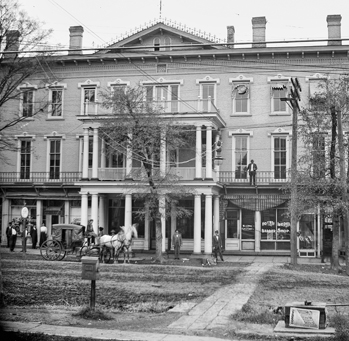Stagecoaches, drawn by teams of two to six horses, were public vehicles that ran scheduled, long-distance routes between designated towns by changing horses at predetermined stops. They took their name from the fact that they undertook journeys in stages, usually 10- to 15-mile laps. By extension, the word "stage" came to refer not only to these laps but also to the places where the coaches stopped and even to the vehicles themselves. In the colonies, stagecoaches began as heavy wagons with backless benches; flat roofs supported by posts left the sides open except in bad weather, when leather curtains could be rolled down. Wagon bodies gradually gave way to more boxlike, closed vehicles. Stagecoaches improved in the 1810s, when egg-shaped vehicles, suspended on leather straps mounted on frames, became the norm.

Stagecoach travel in North Carolina began just after the American Revolution. In 1786 a traveler from Suffolk, Va., to Wilmington, N.C., reported that "the stages" had been established only a short time before and were not yet adequately coordinated. As a result, passengers frequently experienced long delays at transfer points. The establishment of stagecoach lines was left to individual entrepreneurs or to companies of investors; unlike some states, which licensed early stage lines, North Carolina exercised no oversight at either the state or local level. Capt. Nathaniel Twining ran an early line in the eastern part of the state, although service varied in efficiency, comfort, and safety before competing lines forced improvements.
Whatever the quality of service, travel by stagecoach was difficult. Even the most comfortable vehicles were stifling in summer and freezing in winter. If the windows were left open, dust from the road stirred up by the horses and carriage wheels would cover everything inside. Passengers often rode from dawn to late evening and were likely to be roused at 4:00 a.m. to continue a journey. Roads were execrable, and if horses or carriage wheels became mired in mud, passengers had to get out and walk or literally put a shoulder to the wheel. Coaches were also delayed by breakdowns-broken axles were common. Fording streams was also routine, and if the water level was high, patrons could expect to get wet inside their carriage. Moreover, vehicles frequently overturned.
Another uncertainty was the type of accommodations provided at stage stops. Almost uniformly, visitors complained that the inns and taverns in North Carolina were filthy, served unpalatable food, provided rude service, and offered no privacy. According to some travelers, female passengers were forced to crowd into one room, men had to wash in a trough in the yard and to sleep two to a bed, and dinners of chicken swimming in black grease were served with lumps of soggy dough instead of bread.
A travelers' guide from the 1840s listed 18 stage routes in North Carolina with all their stops; 7 originated in Raleigh, radiating out in all directions. In the west, Col. Valentine Ripley of Hendersonville was part owner of a major stage line-Rutledge, Pool, and Ripley-that connected Greenville, Tenn., and Greenville, S.C., via Asheville, Hendersonville, and Flat Rock. Because the terrain was so rough in western North Carolina, travel by stage required changes of teams every eight to ten miles and often six horses instead of the usual four.
Despite their discomfort, stagecoach passengers generally did not complain and often developed a camaraderie with other riders. As stagecoaches were on the verge of extinction, travelers by railroad (which had doomed the stage lines) began to lament their passing and the loss of excitement and intimate contact with villages, countryside, and fellow passengers that stage travel had offered.